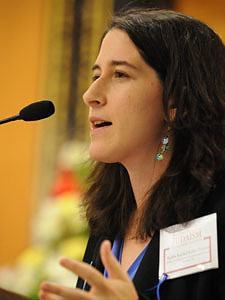Beginning the Torah anew this year with Parshat Bereshit, I have been asking myself what God was trying to tell human beings by creating us at the very end of Creation. Are we the pinnacle of God’s achievements, meant to place our own needs ahead of other forms of life? My answer to this question has an impact on my response to the ongoing crises of climate change and global poverty, two issues I care deeply about. How can we balance sustainable development and population growth with the need to curtail human expansion in response to climate change? I believe that a “human versus planet” outlook is not the only choice, and when I read Parshat Bereshit, I see the potential for synthesis.
In Genesis’s first chapter, humans are at the top of the food chain. God tells Adam: “Fill the earth and master it; and rule the fish of sea, the birds of the sky and all the living things that creep on earth.”[1] In the second chapter of Genesis, however, the role of humans within the natural world is different. God places Adam in the Garden of Eden “to till and to tend it,”[2] with humans meant to be caretakers of the world.
One of my favorite midrashim harmonizes these two perspectives by acknowledging the centrality of humans in creation while still underscoring the need for human beings to serve as stewards of a fragile world. The Rabbis tell the story that when God led Adam around the Garden of Eden, God said, “Look at My works. See how beautiful they are, how excellent! For your sake I created them all. See to it that you do not spoil or destroy My world—for if you do, there will be no one to repair it after you.”[3] The midrash merges the mandates of Genesis 1 and 2, positioning humans as both the beneficiaries and caretakers of the earth. We have the ability to shape the world in ways unknown to other species, and we should use those abilities to further human progress and protect the environment.
But by and large, we have failed to achieve this balance, instead, following only the model found in Genesis 1. We see the effects of human exploitation of the planet in the rapidly evolving climate crisis. As an environmentalist, it seems to me that the solution should be simple: we should revert to our role as stewards and caretakers, minimizing our planetary footprint.
But in practice, sometimes human needs appear to trump environmental concerns. Proponents of development projects like dams and roads believe that the gains in terms of job creation and poverty reduction could far outweigh the loss of trees and contamination of rivers. This is the rationale of growing economies like China and India, which defend their development projects by maintaining that the importance of raising people out of poverty overrides concerns about climate change.[4]
While this sounds reasonable in theory, it is not working on the ground. The large-scale industrial projects springing up in developing countries are not only damaging the land, but are endangering the lives and livelihoods of the people they are ostensibly designed to help. For example, the Urrá Dam, a massive hydroelectric project that was completed in 2000 on the Sinú River in northern Colombia, has devastated the natural habitat surrounding the river and threatened the lives of tens of thousands of indigenous people. As many as 8,500 Embera–Katío people were displaced when the lake filled and an estimated 70,000 lost access to water and native fish species that formed the basis of their diet.[5]
Tragic outcomes like these—even of well-intended projects—are becoming more and more frequent as our exploitation of the earth further disrupts the delicate balance of our planet. Governments and individuals alike must try to achieve harmony between human needs and environmental protection by realizing that they are not in opposition to each other. Sustainable, grassroots development merges the messages of Genesis 1 and 2, ensuring that both the needs of humans and the earth are met. Organizations around the world are raising people out of poverty by providing infrastructure and jobs while reversing environmental degradation. ASPROCIG, an AJWS partner organization, is applying this method in Colombia, helping people displaced by the Urrá Dam to reintroduce native plants and fish and learn cultivation strategies suitable to the new landscape. This organization and others like it are true environmental stewards: tilling and tending the earth and the people who live on it.
As the midrash predicted, the world now needs repairing because we have neglected both imperatives of Genesis: we have spoiled and destroyed God’s world and have not used its resources effectively in service of humanity. Our task now is to rise to the challenge of the midrash, protecting the needs of all humans while serving as caretakers of the natural world. The responsibility is ours, for if we fail, there will indeed be none left to repair the world after us.
[1] Genesis 1:28.
[2] Genesis 2:15.
[3] Ecclesiastes Rabbah 7.13.
[4] Antholis, William J. “India and Climate Change.” The Wall Street Journal, 18 July 2009: A15. http://online.wsj.com/article/SB124787011359360457.html
[5] Kreger, Regina. “Urrá I Dam.” International Rivers. http://www.internationalrivers.org/en/latin-america/mesoamerica/urr%C3%A1-i-dam; “Urrá and the Embera-Katiío, Columbia.” Inventory of Conflict and Environment (ICE) Case Studies. Number x, 5 August 2005. http://www1.american.edu/ted/ice/urra.htm

